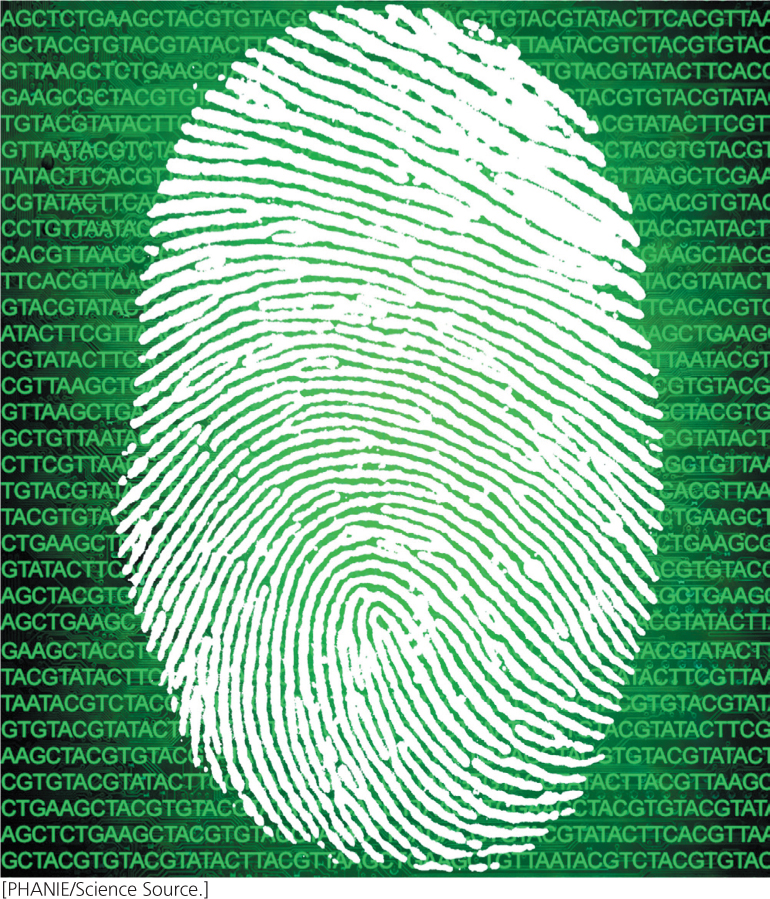The Mystery of Missing Fingerprints
139
In 2007, a 29-year-old Swiss woman attempted to enter the United States. Although her appearance matched the photograph on her passport, she failed a fingerprint check, not because her fingerprints matched those of a terrorist, but rather because she had no fingerprints at all—her fingers were completely devoid of any prints. She was delayed for several hours as puzzled immigration officials tried to decide what to do about a person with no fingerprints.

Fingerprints are among our most unique and permanent traits. No two individuals, not even identical twins, share the same fingerprints. Fingerprints are technically termed epidermal ridges or dermatoglyphic patterns, which are found on our fingers, toes, palms, and the soles of our feet. Epidermal ridges appear long before birth—they are fully formed 17 weeks after conception—and are permanent for life. Research shows that fingerprint patterns are clearly influenced by heredity, but random factors also play a role. One of the first scientists to study fingerprints was Francis Galton, a cousin of Charles Darwin. In the late 1800s, Galton established that no two individuals have the same fingerprints and showed that fingerprints of relatives are more similar than those of unrelated people.
The complete absence of fingerprints, such as that exhibited by the Swiss woman at the airport, is an extremely rare condition known as adermatoglyphia (ADG). Dubbed “immigration delay disease” because of the hassle it creates when people with the condition attempt to cross borders, ADG has been documented only in a few people from four families around the world. In ADG, fingerprints are absent at birth and never develop. Otherwise, the disorder produces no harmful effects.
In 2011, geneticists in Israel and Switzerland solved the mystery of missing fingerprints in people with ADG. Janna Nousbeck and her colleagues examined the condition in a large Swiss family in which some members had normal fingerprints and other members were missing them entirely (Figure 6.1). In this family, ADG exhibits the hallmark characteristics of an autosomal dominant trait: it occurs equally in males and females, it does not skip generations, and every person with the condition has a parent who also has the condition. The researchers took blood samples from family members who lacked fingerprints and those with normal fingerprints. They extracted DNA from the blood and genotyped the family members for 6000 single nucleotide polymorphisms (SNPs), which are DNA sequences that vary in a single nucleotide. By comparing the presence of SNPs in family members with and without fingerprints, they were able to determine that the gene for ADG was located in a specific interval on the long arm of chromosome 4. One of the genes in this region is SMARCAD1, which encodes a short form of a protein found exclusively in the skin. Sequencing of the gene revealed that family members with ADG possessed a mutation not found in those with fingerprints. The mutation causes abnormal splicing in RNA transcribed from the gene, with the result that the RNA is less stable. How the decreased stability of this RNA leads to ADG is not known, but scientists hope that the identification of this gene will lead to a better understanding of how fingerprints develop.

140
The absence of fingerprints is just one of a large number of human traits and diseases that are currently the focus of intensive genetic research. In this chapter, we consider human genetic characteristics and examine three important techniques used by geneticists to investigate these characteristics: pedigrees, twin studies, and adoption studies. At the end of the chapter, we will see how the information garnered with these techniques can be used in genetic counseling and prenatal diagnosis.
Keep in mind as you read this chapter that many important characteristics are influenced by both genes and environment, and separating these factors in humans is always difficult. Studies of twins and adopted persons are designed to distinguish the effects of genes and environment, but such studies are based on assumptions that may be difficult to meet for some human characteristics, particularly behavioral ones. Therefore, it’s always prudent to interpret the results of such studies with caution.